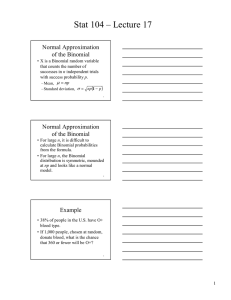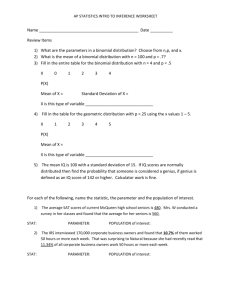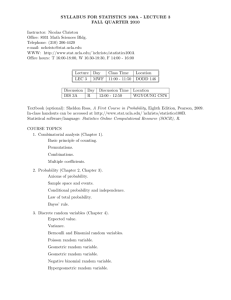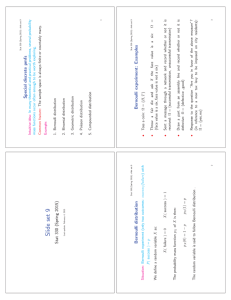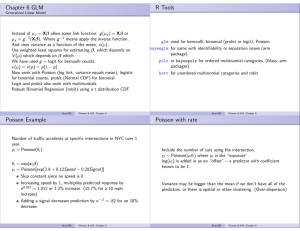Stat 104 – Lecture 14 Binomial R. V.
advertisement
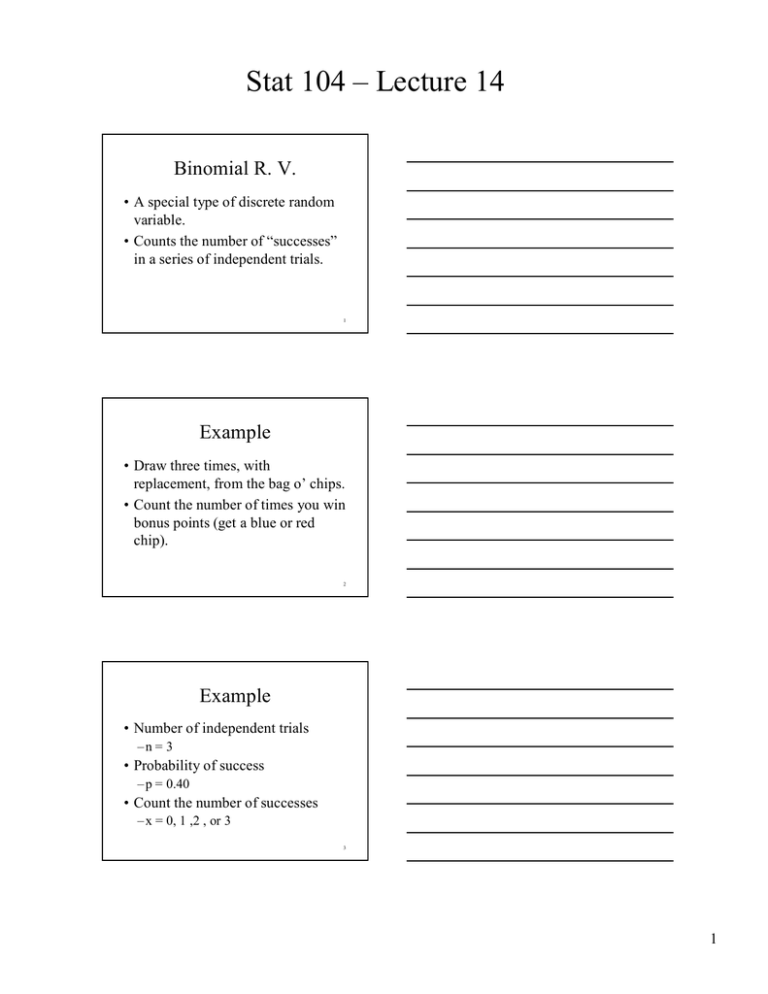
Stat 104 – Lecture 14 Binomial R. V. • A special type of discrete random variable. • Counts the number of “successes” in a series of independent trials. 1 Example • Draw three times, with replacement, from the bag o’ chips. • Count the number of times you win bonus points (get a blue or red chip). 2 Example • Number of independent trials –n = 3 • Probability of success – p = 0.40 • Count the number of successes – x = 0, 1 ,2 , or 3 3 1 Stat 104 – Lecture 14 Tree Diagram Trial 1 Trial 2 Trial 3 x S S F 3 2 F S F 2 1 S S F 2 1 F S F 1 0 S F 4 Probability Distribution • P(3) = (0.4)*(0.4)*(0.4) = 0.064 • P(2) = (0.4)*(0.4)*(0.6) + (0.4)*(0.6)*(0.4) + (0.6)*(0.4)*(0.4) = 3(0.4)2 (0.6) = 0.288 5 Probability Distribution • P(1) = (0.4)*(0.6)*(0.6) + (0.6)*(0.4)*(0.6) + (0.6)*(0.6)*(0.4) = 3(0.4)(0.6)2 = 0.432 • P(0) = (0.6)*(0.6)*(0.6) = 0.216 6 2 Stat 104 – Lecture 14 Binomial R. V. X = number of times bonus points are won on three draws from the bag o’ chips. x 0 P(x) 1 2 3 0.216 0.432 0.288 0.064 7 Binomial R. V. • General formula for the probability function. n x p x P ( x ) = n x = (1 − p )n − x x = 0 ,1,2 ,..., n n! x! (n − x )! 8 Example • n = 3, p = 0.4, x = 2 3 2 P (2) = (0.4)2 (0.6 )3−2 3 ⋅ 2 ⋅1 (0.16)(0.6) (2 ⋅ 1)(1) P (2) = 0.288 = 9 3 Stat 104 – Lecture 14 Binomial R. V. • Mean µ = np • Variance σ 2 = np(1 − p ) 10 Example • n = 3, p = 0.40, (1 – p) = 0.60 • Mean µ = np = 3(0.4 ) = 1.2 • Variance σ 2 = np(1 − p ) = 3(0.4)(0.6 ) = 0.72 11 JMP 12 4 Stat 104 – Lecture 14 Another Example • 38% (p =0.38) of people in the United States have O+ blood type. • If ten (n = 10) people come in to donate blood, what is the chance that 3 (x = 3) of them will have O+? 13 Example • n = 10, p = 0.38, x = 3 10 3 P (3 ) = (0.38)3 (0.62)7 10! (0.054872)(0.035216146) (3! )(7! ) P (3 ) = 0.2319 = 14 P(3) = 0.2319 15 5
